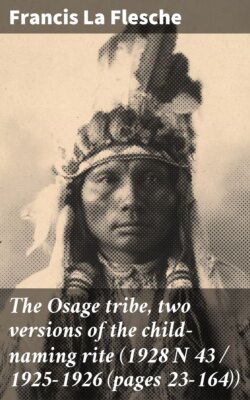Читать книгу The Osage tribe, two versions of the child-naming rite (1928 N 43 / 1925-1926 (pages 23-164)) - Francis la Flesche - Страница 10
На сайте Литреса книга снята с продажи.
CHILD-NAMING RITUAL OF THE PUMA GENS
(Wa-xthi´-zhi)
ОглавлениеTable of Contents
When a man of the Puma gens is prepared for the ceremonial naming of his newly born son he sends for the Sho´-ḳa (official messenger) of his gens. On the arrival of the Sho´-ḳa the father puts before him his customary fee of a blanket or blue cloth and a little pipe which he must carry as his official badge. The father of the child then orders the Sho´-ḳa to go and call the Noⁿ´-hoⁿ-zhiⁿ-ga of the Puma, the Ṭsi´-zhu Wa-shta-ge, and the Wa´-ṭse-ṭsi Wa-shta-ge gentes. The Ṭsi´-zhu Wa-shta-ge is the Peace gens of the Ṭsi´-zhu great tribal division, and the Wa´-ṭse-ṭsi Wa-shta-ge the Peace gens of the Hoⁿ´-ga great tribal division. Prominence was given, in this ceremony, to these two gentes because they are the favored people of the sun and the unclouded sky, the most sacred of the cosmic forces. Through these two favored gentes the blessings of peace and long life are invoked for the child to be named and formally given its place in the tribal unit.
The Noⁿ´-hoⁿ-zhiⁿ-ga of these three gentes assemble in the evening at the house of the father who, in a formal speech, makes known to them the purpose of the summons. Then the heads of the Ṭsi´-zhu Wa-shta-ge and the Wa´-ṭse-ṭsi Wa-shta-ge gentes direct the Sho´-ḳa to go and call the Noⁿ´-hoⁿ-zhiⁿ-ga of the following gentes to assemble at the house of the father on the next morning:
Hoⁿ´-ga A-hiu-ṭoⁿ, Wa-ça´-be-ṭoⁿ and the O´-poⁿ, of the Hoⁿ´-ga subdivision; Wa´-ṭse-ṭsi Wa-shta-ge, Ho´ I-ni-ḳa-shi-ga, Wa-zha´-zhe Çka and the Ṭa´ I-ni-ḳa-shi-ga of the Wa-zha´-zhe subdivision; Ṭsi´-zhu Wa-shta-ge, Ṭsi´-zhu Wa-noⁿ, Mi-k’iⁿ´ Wa-noⁿ and the Tho´-xe of the Ṭsi´-zhu great division.
The Sho´-ḳa, as he goes on this errand, does not neglect the little pipe, his official badge.
